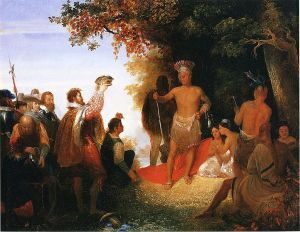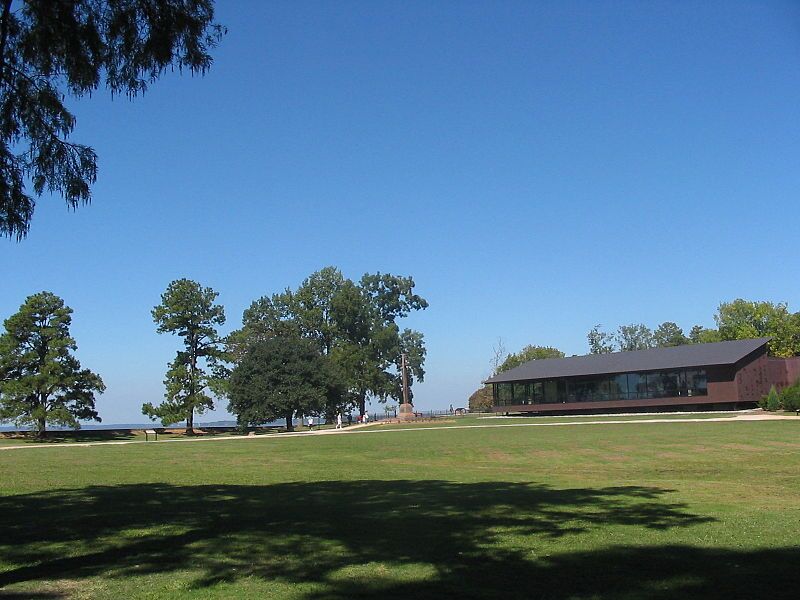
Archaeologists with the Jamestown Rediscovery Project are now exhibiting a representative sampling of the thousands of Native American artifacts they have uncovered over the past 20 years in or near the site of the 1607 James Fort remains on Jamestown Island, the site of the first successful English colony in North America.
Under the rubric, “The World of Pocahontas Unearthed”, the artifacts can now be seen artfully displayed in their own section within the relatively new Voorhees Archaearium, a large one-story copper-sheathed building that rests on pilings designed to protect the seventeenth century-archaeological features and artifacts that lie beneath.
__________________________________
 View of the Archaearium on Jamestown Island. Ser Amantio di Nicolao, Wikimedia Commons
View of the Archaearium on Jamestown Island. Ser Amantio di Nicolao, Wikimedia Commons
___________________________________
“Over the past 20 years we have found thousands and thousands of Virginia Indian artifacts in the excavations………many of them date to the contact period which is, for us, about 1607 to about 1610. So for years, we have had a very elegant museum talking about the English equation or the English side of the story, and clearly there is another half — and that’s the indigenous, the Virginia Indian folks who were here,” says David Givens, a senior staff archaeologist with the Jamestown Rediscovery Project.
Artifacts exhibited include flaked stone projectile points, some of which were made of non-local materials and likely used for cultural exchange, as opposed to hunting and fighting purposes; Indian beads; examples of the 48,000 Indian pottery sherds thus far excavated; clay tobacco pipes that served as models for the English equivalent tobacco pipes; and even one clay pot that features an imprinted pattern of fiber from an Indian basket.
“So when you come to see the exhibit, you can actually ‘see’ a Virginia Indian basket for the first time in over 400 years,” said Givens.
The James Fort site is unique in that it is considered to contain the richest recovered trove of Virginia Native American artifacts in the Chesapeake region, despite the fact that it is primarily an early English colonial site. This is because centuries of mechanized agriculture have disturbed or destroyed most of the Native American village footprints in the ground, while later colonial structures survived as they were set deeper into the soil than those, for example, of the Powhatan villages in the vicinity of the Jamestown settlement.
The Powhatan was a powerful Native American confederation of tribes in present-day Virginia when the Jamestown settlers first arrived. The confederation was led by Chief Powhatan, who was also referred to as “Emperor”. It is thought that there were possibly about 14,000–21,000 Powhatan people in the eastern part of Virginia in 1607 when the English first established James Fort. It was Chief Powhatan’s daughter, Pocahontas, who saved Captain John Smith’s life and later married colonist John Rolf. She bacame a symbol of the relationship that developed between the English Crown and the Native American people of southeastern Virginia.
“The World of Pocahontas Unearthed” can be seen at the Voorhees Archaearium on the grounds of Jamestown Island, not far from the restored colonial town of Williamsburg, Virginia, another major historical site. See the Jamestown Rediscovery website for more information about this and the ongoing excavations and programs related to James Fort and Jamestown.
Cover Image, Top Left: “The Coronation of Powhatan”, by John Cadsby Chapman, courtesy of the Greenville Museum of Art, Greenville, South Carolina
____________________________________________
_______________________________________________________
Read about the most fascinating discoveries with a premium subscription to Popular Archaeology Magazine. Find out what Popular Archaeology Magazine is all about. AND MORE:
On the go? Purchase the mobile version of the current issue of Popular Archaeology Magazine here for only $2.99.
Popular Archaeology’s annual Discovery Edition eBook is a selection of the best stories published in Popular Archaeology Magazine in past issues, with an emphasis on some of the most significant, groundbreaking, or fascinating discoveries in the fields of archaeology and paleoanthropology and related fields. At least some of the articles have been updated or revised specifically for the Discovery edition. We can confidently say that there is no other single issue of an archaeology-related magazine, paper print or online, that contains as much major feature article content as this one. The latest issue, volume 2, has just been released. Go to the Discovery edition page for more information.



